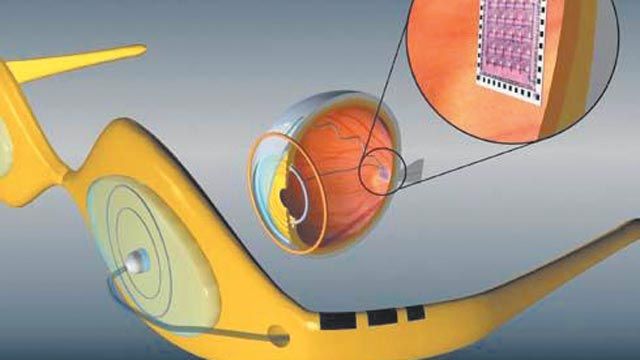Doheny Eye Institute Develops Next-Generation Retinal Prosthesis
"With Computer Vision Toolbox and TI’s C6000 DSP, we rapidly prototype our image and video processing algorithms on the DM642 board. Because we use Simulink, we can modify our algorithms by simply adding or removing blocks and avoid updating the C code directly on the DSP. This can save me days or weeks of time."
Challenge
Solution
Results
- Development time reduced from months to weeks
- DSP deployment streamlined
- Patient testing improved

One of the first symptoms of retinitis pigmentosa is night vision loss. As the condition worsens, peripheral vision is gradually lost, until there is only a single point of light—or none at all. Researchers at the Doheny Eye Institute at the University of Southern California (USC) are giving people with this genetic eye condition hope for restored sight.
Using MathWorks tools, Doheny Eye Institute and its industrial partner Second Sight Medical Products, Inc. are developing a second-generation retinal prosthesis that stimulates nerve cells. The system includes an external camera and real-time software to acquire, process, and convert images into stimulus signals that are delivered to retinal nerve cells through an implanted electronic chip.
The first generation of the investigational implant has produced light perception and basic pattern recognition in patients. The second generation of the implant will increase the resolution of the image from 16 pixels to 60, with subsequent generations featuring higher resolutions, enabling patients to recognize faces and read.
"Improving resolution will be a tremendous step forward," says Dr. James Weiland, Associate Professor at the Doheny Eye Institute. "To make the most of this technology, we need real-time image processing algorithms. MathWorks tools are enabling us to rapidly evaluate, implement, optimize, and test these algorithms on embedded hardware."
Challenge
The image processing unit must also provide real-time response in a portable package. “Our system will need to use DSPs to enable low-power and portable image processing. Because some of our algorithms are computationally intensive, we need a development environment for easily targeting a DSP and optimizing the system.”
Solution
Researchers at the Doheny Eye Institute used MATLAB®, Simulink®, and Computer Vision Toolbox™ to develop image processing algorithms for the retinal implant. The team also used Simulink Coder™ and Embedded Coder® to automatically generate and deploy code onto a Texas Instruments™ (DM64X) DSP.
USC graduate student Neha Parikh and her colleagues began by using MATLAB and Image Processing Toolbox™ to rapidly test new ideas and develop proof-of-concept algorithms on static images.
The team then uses Simulink and Computer Vision Toolbox to incorporate their algorithms into complete systems that process video streams from a camera affixed to eye glasses worn by implant recipients.
Parikh simulated algorithms in Simulink, examining input and output streams as well as intermediate results to simplify debugging and optimization. She then used Simulink Coder to generate a real-time C implementation of her model. Embedded Coder enabled Parikh to deploy the code to a TI DSP. Embedded Coder was used to verify and debug the DSP software in TI’s Code Composer Studio™ embedded software development environment.
At Second Sight Medical Products, Inc., engineers used MATLAB to facilitate psychophysical testing. Engineers created a GUI with MATLAB that clinical investigators can use to specify stimulation parameters. During stimulation, implanted patients provide feedback on the percepts generated, enabling investigators to optimize the stimulation parameters.
Advances in image processing made by Doheny Eye Institute researchers will be incorporated into the next generation of retinal prosthetics, which will be built by Second Sight Medical Products, Inc.
Results
Development time reduced from months to weeks. “After using MATLAB for the proof of concept, it took just a few weeks to develop the real-time embedded system. Without MathWorks tools, I would have needed months to implement the code in C,” says Parikh. “Using MathWorks tools, I can update an algorithm and have it running on a DSP in a few hours.”
DSP deployment streamlined. “In my research, I change my algorithms almost daily. Simulink gives me a much easier and more efficient interface to the DSP,” says Parikh. “I get my results much faster than if I had to code directly on the DSP.”
Patient testing improved. “The flexibility of MATLAB has allowed us not only to increase the sophistication of our experiments but also to use more complex parameters,” says Arup Roy, Senior Systems Engineer at Second Sight Medical Products, Inc. “MATLAB is easier to code than Java™ or C and provides analysis capabilities for processing results.”